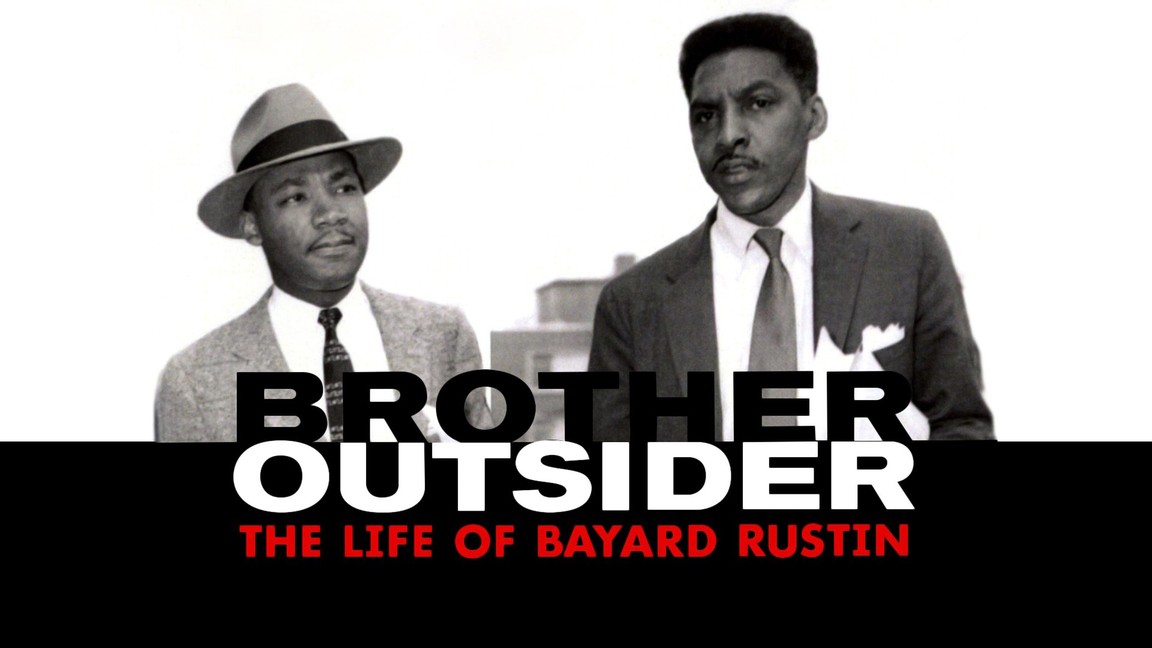Bayard Rustin made history with his advocacy for the LGBTQIA+ community and his role in the March on Washington. Photo courtesy of Rotten Tomatoes.
SAMANTHA RITTENBERG | STAFF REPORTER | srittenberg@butler.edu
Bennett Singer, along with Nancy Kates, co-directed and brought “Brother Outsider: The Life of Bayard Rustin” to Eidson-Duckwall Recital Hall on April 2. “Brother Outsider” explores the story of Bayard Rustin — a strong believer in the philosophy of nonviolence and a prominent activist and strategist who organized the March on Washington. The 83-minute film was cut down to 56 minutes for the showing, followed by a Q&A with Singer.
At the beginning of his career, Rustin was arrested for moral cause, which eventually led to him being publicly outed. From that moment on, Rustin was very open about his sexuality. He was also a big advocate for people in the LGBTQIA+ community and a proponent of teaching AIDS education.
The Butler Collegian had the chance to speak to Singer before the film was shown. From learning about Rustin’s personal life to his heroic career, the conversation was filled with an appreciation for the hidden leaders in history.
THE BUTLER COLLEGIAN: What made you decide to make the documentary about Bayard Rustin?
BENNETT SINGER: One of the very first tasks I had on the Eyes On the Prize team was to research and fact-check the March on Washington section. Within the process, I quickly became aware of Bayard Rustin, whom I had never heard of. [He] became a hero to me and [was] such a determined, courageous and accomplished figure within the civil rights movement. Part of what drew me to his story was [his] influential [role] in shaping the course of the movement. He was instrumental in bringing Gandhi’s ideas of nonviolence from India to America. Then, he became a mentor to Martin Luther King Jr. in the mid-1950s during the Montgomery bus boycott and went on to organize the largest protest in the history of the country, the March on Washington. Through it all, he somehow found the courage to be open about being gay, and that was an inspiration to me.
I was working on this project about social justice and [another] project about speaking truth to power and moving this country in a more progressive direction, but I … was terrified to come out myself. This was the late 1980s, and it was a very different era. Even in progressive circles, there was much more fear and misunderstanding. At the time, delving into Rustin’s story became a personal example for me of someone who was authentic, unashamed and willing to be open about who he was. The film tries to document his public and private lives and looks at the ways in which his openness both liberated him and made him an easy target to denounce and use his homosexuality as a weapon.
TBC: What did your research look like when producing this film?
BS: We spent a long time researching the film on a lot of different levels. In terms of footage, we had a great team of archival footage researchers who ended up finding material on Ruston at over 100 different archives around the world. Rustin was a singer who recorded two albums of spirituals and other songs. We were able to use the music not just as background vocals but as a form of narration. The other source was [countless] pages of FBI surveillance reports that he requested before he died in 1987. His partner, Walter Nagel, shared those with us. Those reports became a crucial part of the storytelling.
TBC: Why isn’t Rustin more well-known when he is such a prominent historical figure?
BS: It’s a reflection [on] how the civil rights movement, social movements [and] the history of activism [are] taught in high school and college. Students learn about civil rights [in terms of Martin Luther King’s] “I Have a Dream” [speech], but it’s not the whole story. Without Rustin, Martin Luther King would have been a very different leader … It was Rustin [who] really helped Dr. King understand what it meant to be a nonviolent leader and follow the tradition of Gandhi and other leaders of nonviolent revolutions.
TBC: How did you balance Rustin’s role as a civil rights leader with his personal struggles in the film?
BS: His professional work as an activist and a strategist was intertwined with his identity as a gay and black man. In some sense, it wasn’t like his public work in life on one side and his private life on the other. He was quite open in the 40s and 50s about being gay at a time when that was really radical, and every state had sodomy laws. It was a crime to engage in same-sex activity … We wanted to show that evolution in terms of how the public and private spheres intersected and how Rustin’s colleagues evolved in supporting him.
TBC: I know several figures from Rustin’s life were featured or mentioned in the film. Was there anyone you reached out to who was opposed to participating?
BS: No, we’re happy the challenge was [that] there were so many potential voices to incorporate. We had 300 hours of material to pack in one hour. It became a real editing challenge to figure out the emblematic stories within our telling of his life. [There was] so much that was left out, but I hope the documentary introduces people to his life and achievements. [He] has this emotional pull on people and gives [viewers] a sense [of] the struggles and the triumphs of the journey he went on.
“Brother Outsider: The Life of Bayard Rustin” is available to stream on Netflix and Kanopy through Butler Libraries.



